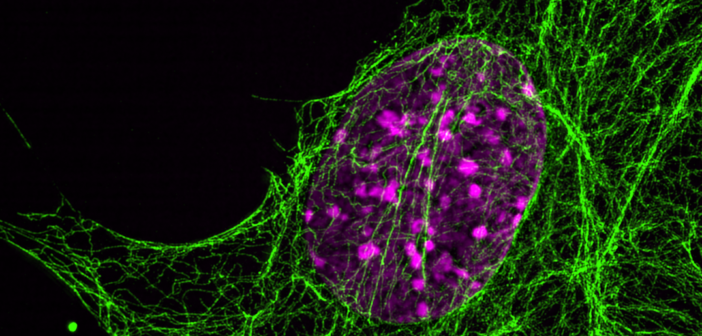
A protein called vimentin helps prevent the nuclei of cells that must navigate through tight spaces in the body from rupturing, according to a recent Northwestern Medicine study published in the Journal of Cell Biology.
Forming a cage around the nucleus, vimentin helps absorb stresses and dampen impacts, ensuring the nucleus — with its valuable genetic information — remains unharmed. This is important both for normal function and in disease, so regulating vimentin has therapeutic potential, according to Robert Goldman, PhD, professor of Cell and Developmental Biology and senior author of the study.
“Under mechanically stressful conditions, cells require a network of polymerized vimentin to maintain cell and tissue homeostasis,” said Goldman, who is also a professor of Medicine in the Division of Pulmonary and Critical Care. “In some cases, cells can increase their production of vimentin in response to stressful conditions and in other cases cells can turn off its production.”

Vimentin is a structural protein in the intermediate filament protein family. These proteins — about 70 in total — are one part of the cytoskeleton system, the network of proteins that comprise the internal skeleton of cells.
Protecting the nucleus from stress as a cell deforms to move through its constricted microenvironment is an important process, one that starts at the very first stages of embryonic development and continues through life, according to Amir Vahabikashi, PhD, a postdoctoral fellow in the Goldman laboratory and co-lead author of the study.
“For example, when the body works to close a wound, cells must migrate from one side of the wound to the other where they have to crawl through constricted spaces,” Vahabikashi said.
While other intermediate filament proteins, namely nuclear lamins, had been discovered to protect the nucleus during cell migration, the role of vimentin in migratory cells was unknown. In the current study, investigators examined cells from mice who were otherwise normal but did not express vimentin, finding significant evidence of ruptured nuclei and damaged DNA in these cells.

Vimentin’s central role in motility and protecting the nucleus in migratory cells could be exploited for therapy in the future, according to Goldman. Cells in tumors, for example, often initiate expression of vimentin as they become motile during the spread or metastasis of cancer cells. Inhibiting vimentin expression or interfering with its functions could potentially halt or slow down the spreading of cancer cells. Vimentin may also protect the nucleus from the mechanical impact of blood flow on the endothelial cells lining blood vessel walls.
“Evidence for this comes from the finding that vimentin in these cells responds to the mechanical stress caused by blood flow,” Goldman said.
One advantage of vimentin over other cytoskeletal proteins like actin or microtubules is that it’s expression is limited to mesenchymal cells which frequently migrate, Goldman said, reducing off-target effects.
“If you target the more ubiquitous cytoskeletal components — microtubules or actin — you hit every cell in the body,” Goldman said. “Vimentin is expressed in different cells than other intermediate filament proteins, so it is a very good target.”
Stephen Adam, PhD, associate professor of Cell and Developmental Biology, was also a co-author of the study. Goldman is a member of the Robert H. Lurie Comprehensive Cancer Center of Northwestern University.
This work was carried out with colleagues in the laboratory of Paul Janmey, PhD, professor of physiology at the University of Pennsylvania, and was supported by the National Institutes of Health, National Institute of General Medical Sciences grant P01 GM096971 and National Cancer Institute training fellowship T32 CA080621-15.






